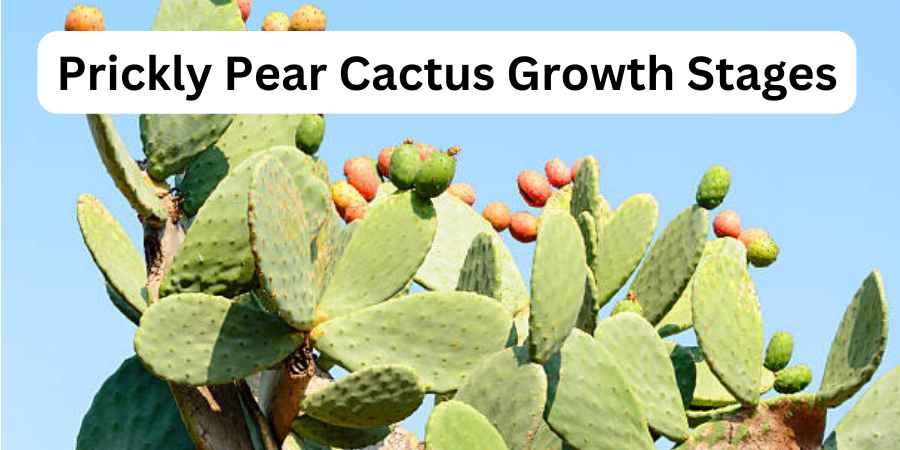Last Updated on June 20, 2025 by Jocelyn
The prickly pear cactus (Opuntia spp.) is a drought-tolerant plant with spiny pads and colorful blooms. It grows up to 8 feet tall and wide, making it suitable for dry landscapes.
Growth begins with a single pad. Over time, it produces more pads that form a dense structure. These pads contain sharp spines that help protect against animals.
In warm seasons, the cactus blooms. Flowers develop into edible fruits called pears. These fruits are sweet and often used in drinks, jams, or eaten raw.
This cactus grows best in full sun with well-draining soil. It adapts to harsh environments and can tolerate frost. USDA zones 4 to 11 are suitable for outdoor growth.
Unlike many succulents, it grows in segments rather than a central stem. New pads can root if detached, allowing natural propagation. This makes it low-maintenance for gardeners seeking resilience and utility.
Table of Contents
Toggle6 Prickly Pear Cactus Growth Stages – From Seed to Splendor
Prickly pear cactus plants go through several important stages in their life cycle. To understand their growth, let’s take a closer look at each stage.
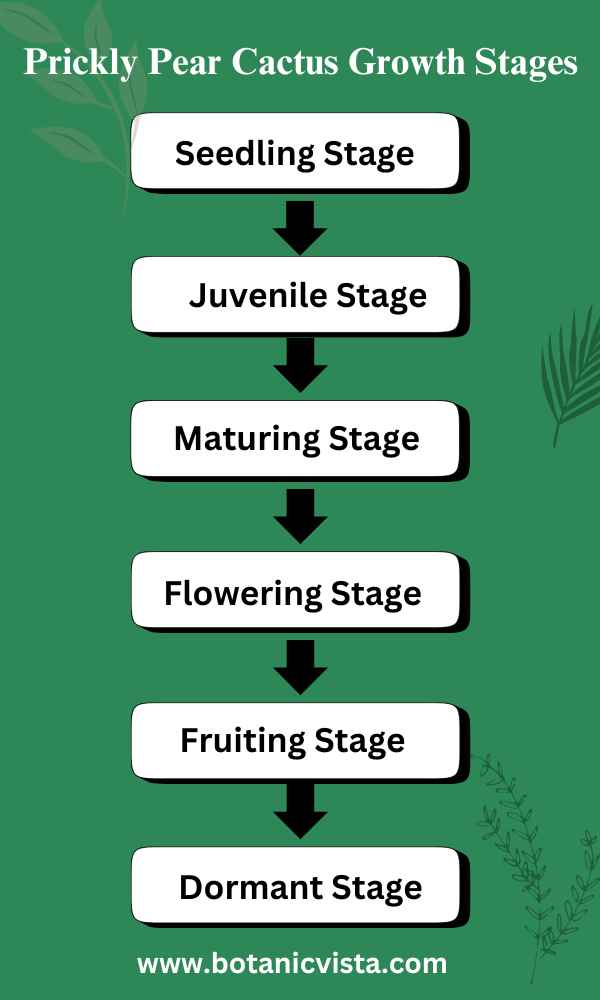
1. Seedling Stage
The Prickly Pear Cactus begins its journey as a tiny seed. To germinate, it needs moist soil and warm temperatures. Indirect light is crucial for these delicate seedlings.
Handle the seedlings with care. Keep the soil slightly moist, but not waterlogged, to prevent rot. Protection from extreme conditions and proper management are necessary for healthy growth.
In about 21 days, you’ll see tiny seedlings emerging. Care during these early stages is essential. The environment should be warm, with light but minimal exposure to direct sun.
Prickly Pear seedlings need time, usually around 180 days, to become more resilient.
2. Juvenile Stage
The juvenile stage is a critical phase for a prickly pear cactus. Use a cactus mix for containers to ensure ample drainage and healthy root development.
Choose a pot that allows the soil to dry out between waterings. Overwatering can harm juveniles. Monitor the watering schedule carefully and adjust for seasonal changes.
Ensure the container size is appropriate. Small pots dry out faster, while larger ones provide more room for growth. Good soil quality is crucial for strong root growth and potential growth.
As the cactus matures, nopales will become more evident. Keep an eye on the nutrient needs during this growth time to encourage healthy root development and successful transition through the juvenile stage.
3. Maturing Stage
The prickly pear cactus starts showing significant growth 3-5 years after planting. During this time, it develops spiky pads and reaches its full size.
It will produce flowers in various colors like yellow and orange, indicating maturity. Depending on the species, it can take a few years for the blooms to appear.
The cactus grows outwards and upwards, showing its impressive shape. Once it reaches maturity, the cactus can reach heights and widths specific to its species.
To help it grow, give it enough sunlight and use a balanced, slow-release fertilizer during the growing season.

4. Flowering Stage
In the flowering stage, the prickly pear cactus blooms. Flowers in purple, yellow, and red appear. Bees and butterflies pollinate, leading to fruit production.
Stick to a consistent watering schedule to avoid overwatering. This keeps the cactus healthy and prevents toppling.
In early summer, enjoy the spectacle of colors. The flowers bring joy and promise fruits. This stage is a true striking sight, both indoor and in the right climate conditions.
Pollinators like bees and butterflies help in transferring pollen, ensuring a well-established cactus and full fruit production.
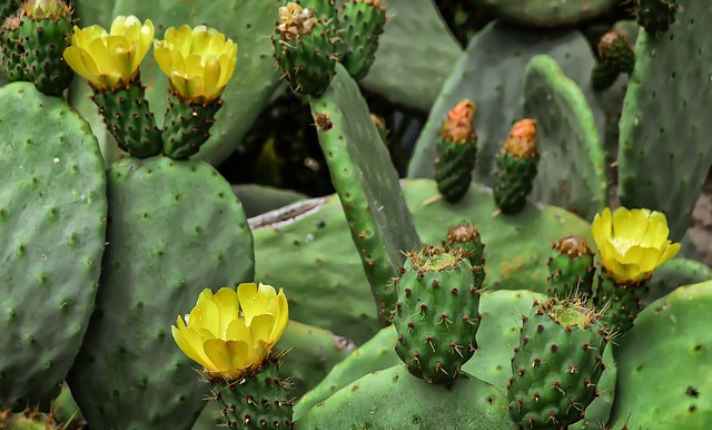
5. Fruiting Stage
In the fruiting stage, the prickly pear cactus starts to set fruits. These fruits, also called tunas, begin to ripen after flowering. It’s important to focus on the cactus’s health during this time.
First, the blooms of the cactus turn into sweet, edible fruits. This process takes a few weeks. The colors of the fruit can vary, making the plant quite attractive in any garden.
When the fruit is ready for harvesting, you need to be careful. The prickly nature of the plant means you must use gloves to protect your hands and eyes from the spines.
The fruits are not just valued for their taste; they are also a staple in some cultures. They are harvested and eaten fresh, cooked, or made into drinks.
Keep in mind, that pests can be a problem. Regular checking helps in maintaining the health of your plant. By cutting off any affected parts, you ensure the development of healthy fruits.
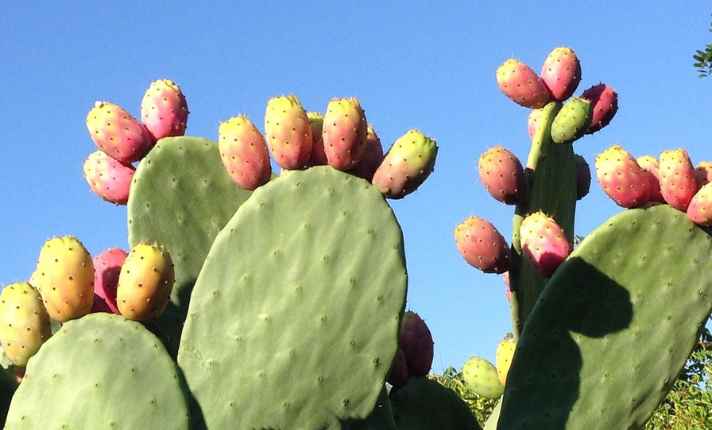
6. Dormant Stage
When temperatures drop in the cooler months, the prickly pear cactus enters a dormant stage. During this period, growth ceases significantly. Gardeners need to reduce watering and fertilizing to mimic the cactus’s natural cycle.
To conserve energy, the plant uses less water. This period typically occurs until spring when temperatures rise again. Handling the cactus with care is crucial. Repotting and other tasks should be minimized.
During this seasonal stage, life for the cactus slows down. Gardeners often worry about overwatering. The key is to keep the plant in colder conditions to help it rest. Avoid unnecessary watering to conserve the plant’s energy.
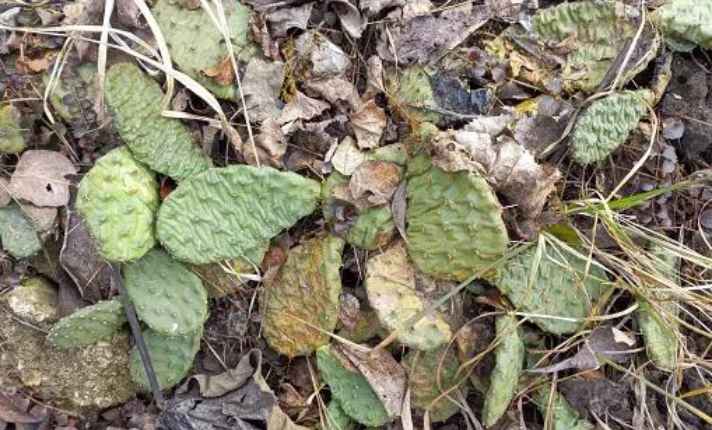
Prickly Pear Cactus Growing Conditions
Prickly Pear Cactus needs specific growing conditions. They love dry, rocky soil with good drainage. Direct sunlight is essential, especially from south-facing or west-facing slopes.
These cacti expand 1 to 2 feet (30 to 60 cm) each year, so give them plenty of space.
Planting in the Garden
In the garden, plant the cactus where it gets full sun. The desert is their natural home, so they adapt well to occasional rainfall and high temperatures. Be careful with humidity; too much can cause issues.
Growing in Containers
Containers with good drainage work well if you grow them indoors. Ensure they get plenty of direct sunlight to keep them healthy. Place them where they receive at least 6 or more hours of direct sunlight each day.
Light Requirements
Direct sunlight is crucial for the cactus. Place them in south-facing or west-facing spots to ensure they receive ample sunlight. Without enough light, they won’t grow well and might not produce fruit.
Soil and Fertilizers
Prickly Pear Cactus thrives in dry, rocky soil with good drainage. They don’t need many nutrients. Feeding once a year with a balanced fertilizer is enough. Over-fertilizing can harm the cactus.
Watering and Care
Water the cactus occasionally. Too much water can cause scald on the pads. Ensure the soil is well-drained to avoid waterlogging. In cold periods, protect the cactus from frost. These cacti are resilient but still need occasional care.
Flowering and Fruiting
As the cactus grows, it will produce flowers and sweet berries. The fruiting stage is exciting, with beautiful flowers appearing before the fruit. The fruit is typically 1-3 inches in size. Handle the cactus with care due to its prickly spines.
Common Issues in Prickly Pear Cactus Growth
Growing prickly pear cacti can be fun, but you may face some common issues. Here are some key points to remember:
| Problem | Cause | Solution |
| Overwatering | Causes root rot | Leads to black spots on the pads |
| Fungal infections | Leads to black spots on pads | Poor ventilation promotes fungi |
| Phyllosticta fungus | Causes black spots | Dispose of infected pads |
| Aphids, scales, spider mites | Infests cactus | Use insecticidal soap, rubbing alcohol |
| Overcrowding | Promotes fungi, hinders growth | Avoid overcrowding, improve airflow |
| Wet weather | Regular checks use natural remedies | Ensure proper drainage, keep dry |
| Nearby plants | Can spread pests | Check regularly, separate if needed |
| Humid weather | Increases fungal risk | Keep in dry areas, ensure airflow |
| Indoor plants | Susceptible to pests | Regular checks, use natural remedies |
FAQ’s
Q: Do Prickly Pear Cactus Multiply?
A: Prickly pear cactus multiply by both seeds and broken stems. Seeds, when sown in flats, grow into new plants. Additionally, if a stem falls and takes root, it can become a new cactus.
Q: What Does an Overwatered Prickly Pear Cactus Look Like?
A: An overwatered prickly pear cactus has yellow leaves, and wet soil, and can rot or even burst. In this state of distress, the cactus shows signs of water stress, unlike an underwatered one that looks parched and dry.
Q: Can You Cut Prickly Pear and Replant?
A: Yes, you can cut a prickly pear and replant it. Then, plant it upright in moist soil, ensuring it’s evenly watered but not soggy to prevent rot.
Try misting the top to keep it moist and place the container in a good light spot, avoiding the center of direct sunlight.
Q: Can Prickly Pear Get Too Much Sun?
A: Prickly pear plants need sunlight but too much direct sun can make them unhappy and crispy. Ensure moderation by giving them shade during peak sun exposure. Proper balance keeps the pear plant healthy.
Q: Why Is My Prickly Pear Bending Over?
A: Your prickly pear cactus might be drooping due to overwatering, inadequate sunlight, or weak roots.
To fix this, adjust watering, provide more sunlight, and support the cactus to stay upright. Check for signs of rot and prune if necessary.
Conclusion
Growing a prickly pear cactus takes patience and care. Its gradual growth from a small seed to a sprawling cactus is remarkable.
With proper care techniques and the right environmental conditions, it can flourish and produce stunning blooms and fruits. The journey showcases the plant’s unique beauty and resilience, making the effort truly worth the wait.
Also read:
